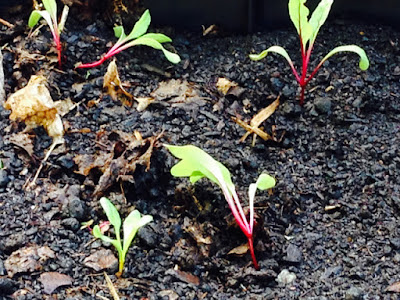Depending on whether your garden is on the edge of the woods
or in the center of a city, it will be plagued to varying degrees by
wildlife. For some gardeners, it’s just
a matter of deterring fruit-eating birds and bulb-digging squirrels. Other gardeners must contend with regular
visits from deer, groundhogs (aka woodchucks) and rabbits too.
In my case, a deer trail runs on top of a steep hill behind
my house.
My first few years gardening here were met with mixed
success. Not used to living in
deer-country, I was dismayed to find the tomatoes I planted were eaten just as
the fruit ripened. Over the years, my
family tried various strategies such as surrounding our garden with snow
fencing, which proved cumbersome and not terribly effective.
One year I successfully grew a few butternut squash plants
deeply intermixed with plants that deer normally do not eat. Unlike planting a mass of edibles all together
in a garden plot (which seem to shout to the deer “We’re here! We’re here!
We’re here!”), edibles that are scattered individually often remain
below the radar of deer. Perhaps the
critters did not find it worth their while to invest the energy to come and
eat them.
Every year at the end of June, apples from an old tree drop
onto the corner of our property, and without fail the apples become a deer
magnet. In the evenings, we see deer
munching on the fallen apples. Once the deer have made the detour to forage
under the apple tree, they check out what else is edible around our house. Daylilies and other plants that were thriving
in early June are eaten in one fell swoop at the end of June.
Garden in nooks and crannies: Make use of microenvironments
that are inaccessible to deer and groundhogs.
When my daughter was eleven, she wanted to plant tulips- red
ones, and lots of them. Unfortunately,
tulips are like candy to deer, and where we live, tulips don’t stand a
chance. However, thinking about deer, we
realized that we did have a place that the deer would not venture. We have a high rock wall, with a picket fence
on top leaving just a few inches of soil between the edge of the rocks and the fence.
As a general rule, deer do not jump into confined spaces that are too small
for the deer to take a running leap out.
Here was the perfect tulip nook.
We selected the tulips – Red Hunter Species Tulips, which are hardy as
far as tulips go, and World’s Favorite Darwin Tulips, and we planted them on
top of the wall that fall. Our tulip
nook worked – the deer left them alone, and they looked stunning next to the
garden phlox that cascades over the wall. Years later, the tulips still put on a show.
 |
| Tulip nook on top of rock wall is inaccessible to deer |
 |
Bird's eye view of tulips and phlox growing between the fence and the top of the rock wall
|
 |
| Phlox on top of the wall being pollinated by a tiger swallowtail butterfly |
Garden near your house.
Many times (but not always) animals will not venture up onto a front
porch. A friend of mine, who often has
deer in her backyard, is able to grow tomatoes in containers on her porch. Growing deer-favorites in window boxes and
hanging baskets are options too.
Have you found ways to outsmart the deer by taking advantage
of thorny bushes, high walls, small spaces, and other conditions that make an
area inaccessible to deer? Have you ever planted at low densities and managed to sneak below
the deer radar? Please share your
attempts in the comments below.


















